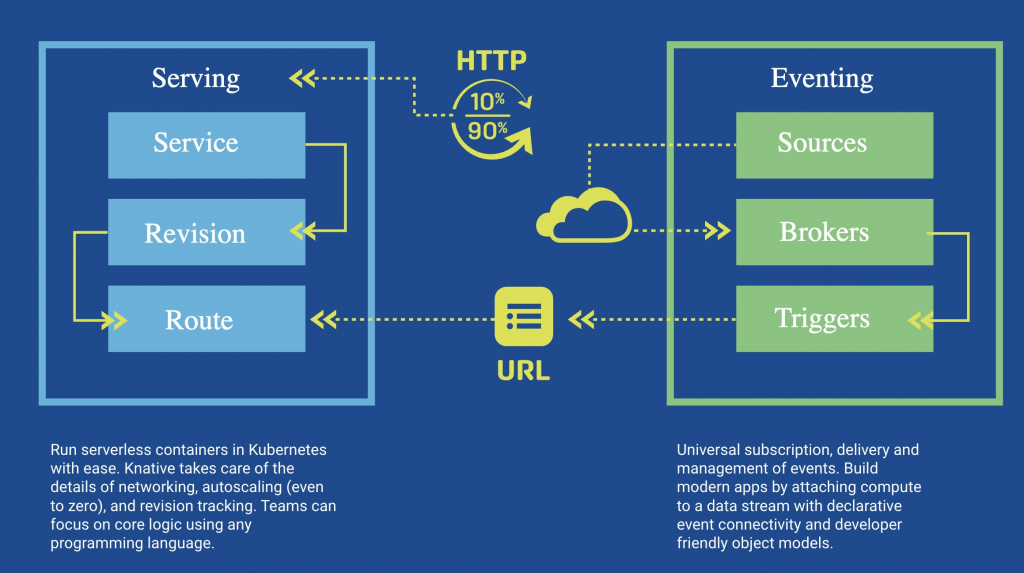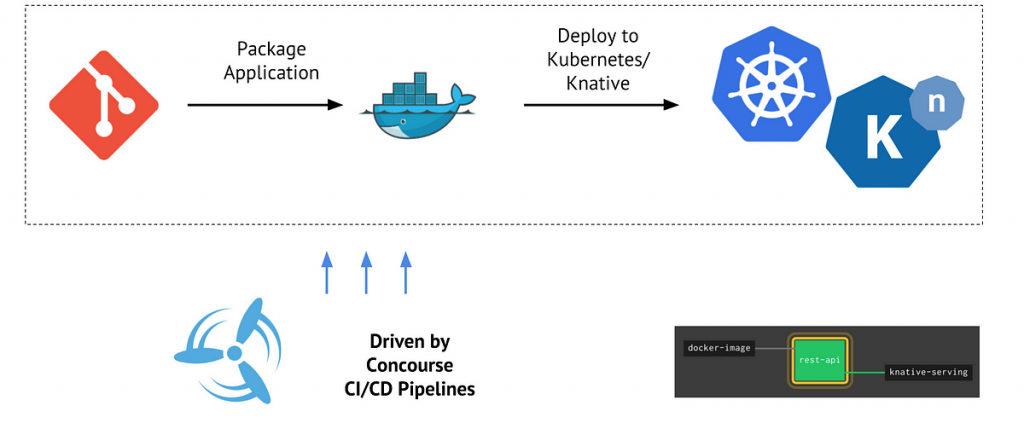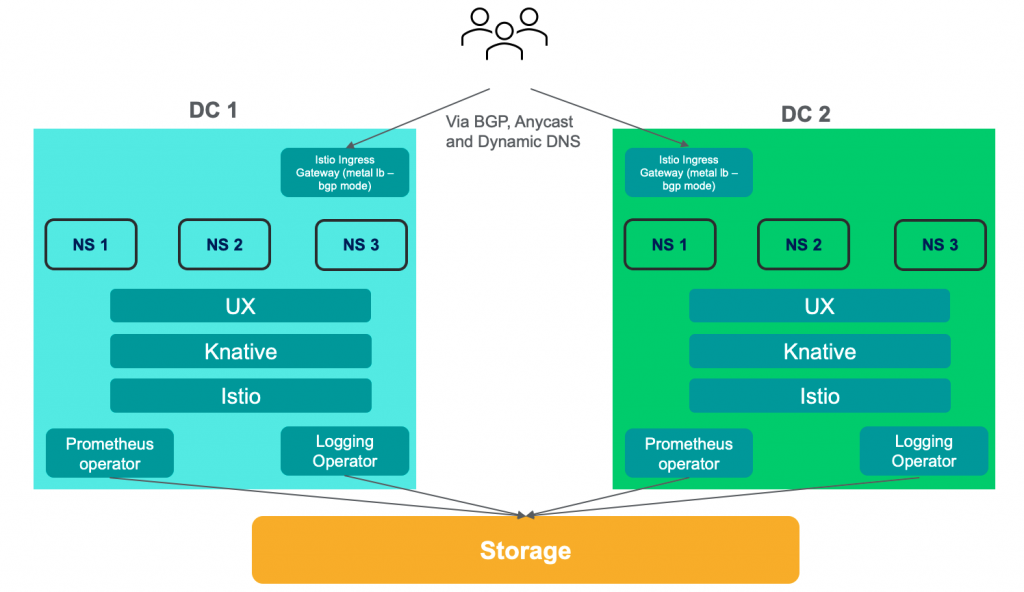
1. What is Knative?
Knative is an open-source platform that helps developers build, deploy, and manage serverless workloads on Kubernetes.
2. What are the benefits of using Knative?

Knative makes it easier for developers to create and manage serverless applications. It also helps with scaling and managing resources.
3. How does Knative work?
Knative uses Kubernetes to manage serverless workloads. It provides a set of building blocks that developers can use to create and manage their applications.
4. What programming languages does Knative support?
Knative supports a variety of programming languages, including Java, Python, and Node.js.
5. What is a serverless application?

A serverless application is an application that runs on a serverless platform, where the infrastructure is managed by the platform provider.
6. What is Kubernetes?
Kubernetes is an open-source platform for managing containerized workloads and services.
7. How does Knative differ from Kubernetes?
Knative builds on top of Kubernetes to provide a platform for building and managing serverless workloads.
8. What is a container?
A container is a lightweight, standalone executable package that contains everything needed to run an application, including code, libraries, and dependencies.
9. What is a pod in Kubernetes?
A pod is the smallest deployable unit in Kubernetes. It contains one or more containers and shared storage and network resources.
10. What is a service in Kubernetes?
A service is an abstraction that defines a logical set of pods and a policy for accessing them.
11. What is a deployment in Kubernetes?
A deployment is a Kubernetes object that manages a set of replicas of a pod template.
12. What is a namespace in Kubernetes?
A namespace is a way to divide cluster resources between multiple users or teams.
13. What is a secret in Kubernetes?
A secret is an object that contains sensitive data, such as passwords or API keys.
14. What is a config map in Kubernetes?
A config map is an object that contains configuration data, such as environment variables or configuration files.
15. What is Istio?
Istio is an open-source service mesh that provides traffic management, security, and observability for microservices.
16. How does Istio work with Knative?

Istio can be used with Knative to provide advanced traffic management and security features.
17. What is a build in Knative?
A build in Knative is a process that creates a container image from source code.
18. What is a revision in Knative?
A revision in Knative is a specific version of an application that can be deployed and scaled independently.
19. What is a route in Knative?
A route in Knative is a way to expose a revision to incoming traffic.
20. What is a service in Knative?
A service in Knative is a higher-level abstraction that defines a set of routes and revisions.
21. What is a trigger in Knative?
A trigger in Knative is a way to automatically start a build or deploy a revision based on an event.
22. What is a source in Knative?
A source in Knative is a way to define where events come from, such as a Git repository or a message queue.
23. What is a sink in Knative?
A sink in Knative is a way to define where events go, such as a function or a message queue.
24. What is a broker in Knative?
A broker in Knative is a way to route events between sources and sinks.
25. What is a function in Knative?
A function in Knative is a serverless function that can be triggered by an event.
26. What is a container image?
A container image is a lightweight, standalone executable package that contains everything needed to run an application, including code, libraries, and dependencies.
27. What is a Dockerfile?
A Dockerfile is a text file that contains instructions for building a Docker container image.
28. What is a container registry?
A container registry is a place to store and distribute container images.
29. What is a Kubernetes cluster?
A Kubernetes cluster is a set of nodes that run containerized applications and services.
30. What is a node in Kubernetes?
A node in Kubernetes is a physical or virtual machine that runs containers.
31. What is a pod template in Kubernetes?
A pod template in Kubernetes is a specification for creating pods.
32. What is a replica set in Kubernetes?
A replica set in Kubernetes is a Kubernetes object that manages a set of replicas of a pod template.
33. What is a horizontal pod autoscaler in Kubernetes?
A horizontal pod autoscaler in Kubernetes is a Kubernetes object that automatically scales the number of replicas of a pod template based on CPU utilization.
34. What is a vertical pod autoscaler in Kubernetes?
A vertical pod autoscaler in Kubernetes is a Kubernetes object that automatically adjusts the resource requests and limits of containers based on their resource usage.
35. What is a service mesh?
A service mesh is a dedicated infrastructure layer for managing service-to-service communication within a microservices architecture.
36. What is a sidecar container?
A sidecar container is a container that runs alongside the main container in a pod and provides additional functionality, such as logging or monitoring.
37. What is a circuit breaker?
A circuit breaker is a design pattern for handling network failures in a distributed system.
38. What is a load balancer?
A load balancer is a device or software that distributes network traffic across multiple servers.
39. What is a health check?
A health check is a periodic check to ensure that a service is running and responding correctly.
40. What is a rolling update?
A rolling update is a deployment strategy that updates a service by gradually replacing old instances with new ones.
41. What is a canary deployment?
A canary deployment is a deployment strategy that releases a new version of a service to a small percentage of users to test for issues before rolling it out to everyone.
42. What is a blue-green deployment?
A blue-green deployment is a deployment strategy that releases a new version of a service alongside the old version and switches traffic to the new version once it is ready.
43. What is a feature flag?
A feature flag is a way to toggle a feature on or off in a service based on a configuration setting.
44. What is a monolith?
A monolith is a large, complex application that is difficult to maintain and scale.
45. What is a microservices architecture?
A microservices architecture is an approach to software development that structures an application as a collection of small, independent services that communicate with each other through APIs.
46. What is a serverless function?
A serverless function is a piece of code that runs in response to an event, without the need for a dedicated server or infrastructure.
47. What is a cloud provider?
A cloud provider is a company that offers cloud computing services, such as Amazon Web Services or Microsoft Azure.
48. What is a cloud-native application?
A cloud-native application is an application that is designed to run on a cloud platform, using cloud-native technologies and architectures.
49. What is a DevOps engineer?
A DevOps engineer is a professional who combines software development and IT operations expertise to manage the entire software development lifecycle.
50. What is a CI/CD pipeline?
A CI/CD pipeline is a set of automated processes for building, testing, and deploying software changes.
Related video:
- Degree Pursuit: Navigating the Path to Educational Excellence - July 4, 2024
- Why Is Studying English Important in a Business Environment? - July 4, 2024
- Top 10 Data Science Skills You Need in 2024 - July 3, 2024

